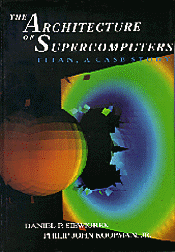The Architecture of Supercomputers: Titan, a Case Study

The Architecture of Supercomputers: Titan, a Case Study |
|
 |
Daniel P.
Siewiorek
Philip J. Koopman, Jr.
Academic Press, 1991
ISBN: 0-12-643060-8
Overview:
This book describes the architecture of the first member of a new class of computers, the graphic supercomputer workstation. The authors concentrate on the motivation for defining a new class of computer architectures as well as on the form of the architecture that responds to the requirements for this new class.
Written both for the technical professional and for students interested in computer architecture, the study of the Titan architecture yields insights into a historically significant machine while examining its architectural principles both in isolation and in their interdependence with various design decisions. The book employs taxonomy as a means of organizing the discussion. Since performance is of paramount importance, a separate taxonomy and discussion on performance metrics is provided.
In order to keep the discussion self-contained, the authors provide an evolutionary description of architectural and performance concepts and a glossary with concise definitions of the major terms and concepts. In addition, the book contains a brief, high-level summary of the major features of the Titan architecture as well as detailed appendices.
[Free sample: Gordon Bell's Eleven Rules for supercomputer design.]
Forward by Gordon Bell
1. Titan architecture overview
1.1 Visualization of Scientific Computation
1.2 System Overview
1.3 General Operation Principles
1.4 From Concept to Realization
1.5 The Next Generation
2. Architectural evolution -- issues and solutions in high-performance
design
2.1 In the beginning: uniprocessors
2.2 Memory performance hierarchies
2.3 Speedup through specialization
2.4 Concurrency through overlap of operations
2.5 Concurrency through replication
2.6 Vector operations
2.7 Limits to speedup: Amdahl's Law
2.8 Summary
3. Performance and balance
3.1 Hardware performance measures
3.1.1 Pc.
3.2 Kiviat graphs
3.3 System performance measures
3.4 The importance of balance
4. Hierarchical model of computation
4.1 A High level model of computation
4.2 A more detailed model of computation
4.3 Primitive operations
5. Titan architecture and its implementation
5.1 System bus
5.2 Memory
5.3 Integer unit
5.4 Vector processing unit
5.5 Graphics processing unit
5.6 I/O
5.7 Reliability features
5.8 An example of system operation
5.9 Feature Summary
6. Architectural analysis of Titan
6.1 System bus
6.2 Memory
6.3 Integer unit
6.4 Vector processing unit
6.5 Graphics processing unit
6.6 I/O
6.7 Analysis of system throughput & plumbing diagram
7. Benchmarks and performance measurement
7.1 LINPACK and LAPACK
7.2 Elementary functions
7.3 The P3 modifications for improved performance
7.4 The Eleven Rules of supercomputer design
Appendix A. The Titan Bus
Appendix B. Titan P2 Specification Summary
Appendix C. Glossary of Terms
Phil Koopman -- koopman@cmu.edu